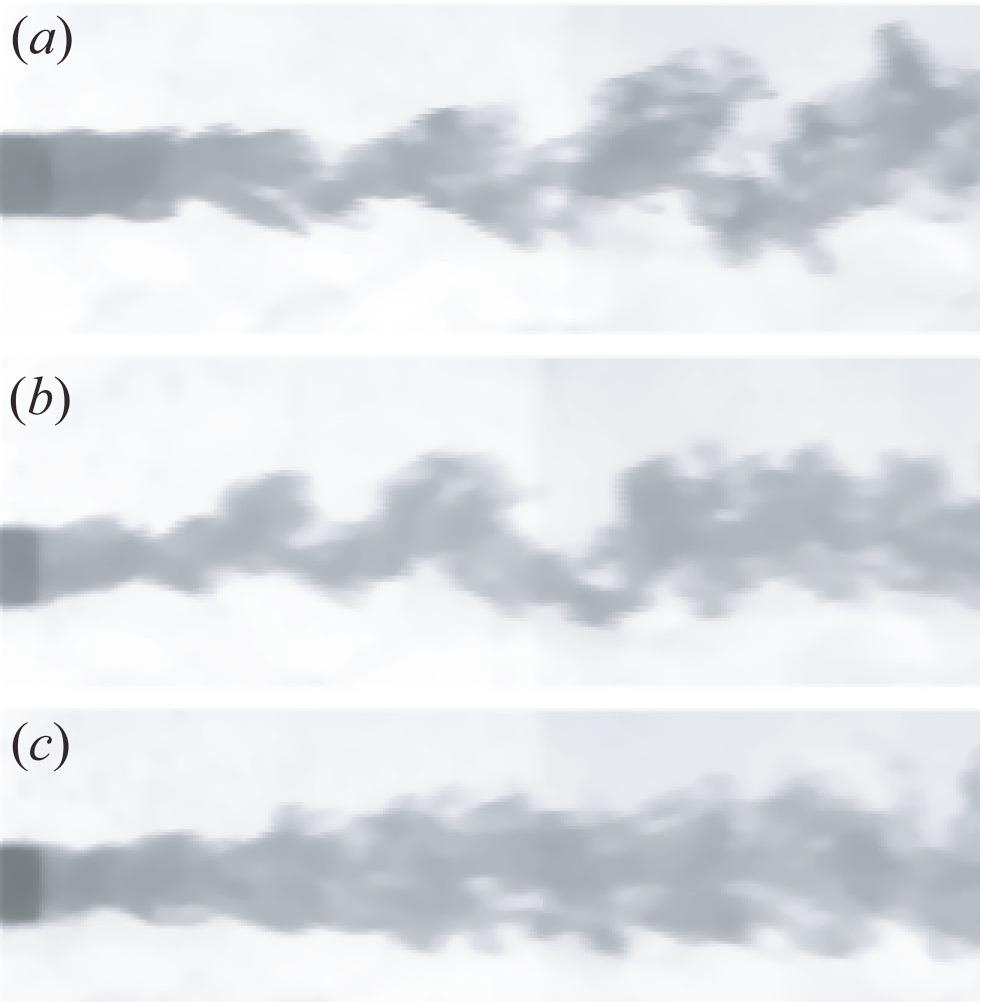Estabilidad y control de estelas y chorros
The flow around bluff bodies is of great interest in many technological applications. In most cases the wake turns out to be non stationary and unstable, producing modes whose frequencies are clear and independent of background noise. On the other hand, the close wake instability causes fluctuating forces acting on the body and surrounding bodies when exist, and oscillations on Drag and Lift coefficients. To better understand the physics of the problem and to characterize the transition to non-stationarity, the Fuids Mechanics Group of Univeristy of Jaén has been carrying out experimental work (hot-wire anemometry and visualizations), direct numerical simulations and global and local stability analyses in the wake of slender axisymmetrical blunt based bodies (bullet-shaped bodies) for several years; focusing this work on both high and low Reynolds (Re) number flows.
As Re increases, the wakes suffers two bifurcations, starting at the axysymmetrical state for low Re. The first bifurcation (taking place at the stationary critical Reynolds, ) breaks the axisymmetry and leads to a new planar symmetry stationary state, that remains valid until the second bifurcation (oscillatory critical Reynolds,
) when the flow becomes time dependent, and pairs of counter-rotating vortices are shed periodically while keeping the symmetry plane. Finally, a third state is reached where a low frequency modulation exists (about one-quarter of the leading one). We have shown that increasing body lengths stabilize both the first and second critical Reynolds.
Figure 1. Streamwise vorticity contours for a body of aspect ratio and
>
We also investigate control methods to inhibit the oscillations and stabilize the wake. Among them, base bleed has been proved to inhibit vortices shedding and effectively suppress large-scale structures in high Re flows. It is shown that both bifurcations can be stabilized by injecting a certain amount of fluid with the same density than the free stream one through the base of the body, quantified as the bleed-to-free-stream velocity ratio, . For a given Re that produces the non-stationary oscillating wake, a bleed ratio value
eliminates the vortices shedding, and recovers the stationary planar symmetry state. If this ratio is increased until it reaches
, the axisymmetry will be again obtained. The effect of the bleed-to-freestream density ratio,
on the stability properties has been also studied through local stability analysis, finding that low ratios (
<
) inhibit the wake for smaller bleed ratios than in the homogeneous case (
).

Figure 2. Visualizations of the wake for a body with aspect ratio , for Re=2800 and several values of the bleed coefficient (
): (a)
=0.04, (b)
=0.09, and (c)
=0.13>
.
Rear cavities are found to stabilize the wake as well. They can shift the bifurcations occurrence to higher values of , so that the deeper the cavity is, the bigger the values
and
becomes. This fact reaches a limit for a critical cavity depth
, from where the stabilization effect no longer grows (asymptotic behavior).
Researchers
Patricio Bohórquez Rodríguez de Medina
Alejandro Sevilla Santiago (Universidad Carlos III de Madrid)
Supporting projects
Spanish Ministry of Science and Innovation and European Funds
DPI2008-06624-C02, DPI2005-08654-C04-01 and DPI2002-04550-C07-06.
Junta de Andalucía and European Funds
P07-TEP02693.
Universidad de Jaén
UJA-08-16-19.
Publications
– J.I. Jiménez-González, A. Sevilla, E. Sanmiguel-Rojas & C. Martínez-Bazán. Global stability analysis of the axisymmetric wake past a spinning bullet-shaped body. Journal of Fluid Mechanics (Accepted, 2014).
– J.I. Jiménez-González, E. Sanmiguel-Rojas, A. Sevilla & C. Martínez-Bazán. Laminar flow past a spinning bullet-shaped body at moderate angular velocities. Journal of Fluid and Structures, Vol. 43, 200-219 (2013).
– E. Sanmiguel-Rojas, J.I. Jiménez-González, P. Bohórquez, G. Pawlak & C. Martínez-Bazán. Stability effects of base cavities on the wakes of slender blunt-based axisymmetric bodies. Physics of Fluids, Vol. 23, 114103 (2011).
– P. Bohórquez, E. Sanmiguel-Rojas, A. Sevilla, J.I. Jiménez-González & C. Martínez-Bazán. Stability and dynamics of the laminar wake past a slender blunt-based axisymmetric body. Journal of Fluid Mechanics, Vol. 675, 110-144 (2011).
– E. Sanmiguel-Rojas, A. Sevilla, C. Martínez-Bazán & J.-M. Chomaz. Global mode analysis of axisymmetric bluff-body wakes: stabilization by base bleed. Phys. Fluids 21, 114102 (2009).
– A. Sevilla & C. Martínez-Bazán. A note on the stabilization of bluff-body wakes by low density base bleed. Phys. Fluids 18, 098102 (2006).
– A. Sevilla & C. Martínez-Bazán. Vortex shedding in high Reynolds number axisymmetric bluff-body wakes: Local linear instability and global bleed control.Phys. Fluids 16, 1037 3460–3469 (2004).